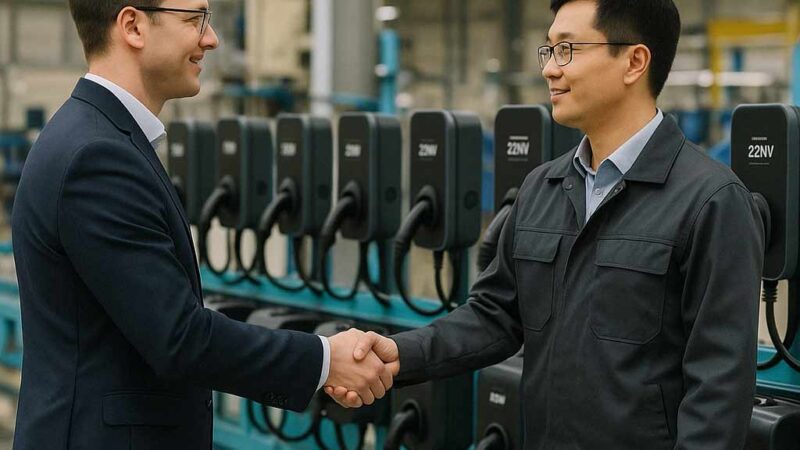Selecting the right 22kW EV Charging Station Manufacturer is a pivotal step in ensuring your electric vehicle (EV) infrastructure meets performance expectations, budget constraints, and long-term reliability. For many global buyers, partnering with a Chinese supplier offers an optimal combination of competitive pricing, manufacturing expertise, and comprehensive OEM/ODM services. This guide provides a step-by-step approach to evaluate, shortlist, and finalize a Chinese 22kW EV charging station manufacturer tailored to your project’s unique requirements. By following these best practices, you can minimize risk, optimize costs, and accelerate your deployment timeline—all while adhering to SEO best practices for the core keyword 22kW EV Charging Station Manufacturer.
Table of Contents
1. Define Your Project Scope and Requirements
Before engaging potential manufacturers, crystallize your project objectives:
Deployment Scale: Determine the number of stations required (e.g., pilot batch vs. large-scale rollout of 100+ units).
Installation Environment: Indoor parking garages, outdoor commercial lots, or mixed-use residential complexes have distinct environmental and mounting needs.
Key Features: Dynamic load balancing, smart grid communication (OCPP 2.0.1), authenticated access (RFID/NFC), and user interface preferences.
Regulatory Compliance: List necessary certifications such as CE, UL, ISO 15118 (for V2G), and national grid approvals.
Budget and Timeline: Set realistic per-unit cost targets (FOB or CIF) and critical milestone dates for prototype, pilot, and production deliveries.
Documenting these criteria in a clear requirements specification ensures all manufacturers are assessed on the same basis, streamlining comparisons and contract negotiations.

2. Why Choose a Chinese 22kW EV Charging Station Manufacturer?
China has emerged as a global manufacturing powerhouse for EV infrastructure. Key advantages include:
Cost Competitiveness: Lower labor and material costs enable Chinese OEMs to offer per-unit pricing 10–20% below Western counterparts, especially at scale.
Vertical Integration: Many Chinese suppliers control end-to-end production, from sheet metal stamping to PCB assembly and enclosure molding, reducing sub-supplier risks and lead times.
Customization Expertise: Experienced OEM/ODM teams in China can rapidly adapt hardware and software features—such as custom enclosures, UI branding, and integration with proprietary backend systems.
Accelerated R&D and Sampling: Design houses and factories often co-locate near Shenzhen/Guangdong, enabling rapid prototype iterations (2–4 weeks) and pilot production runs.
Global Certification Assistance: Established relationships with accredited testing labs streamline CE/UL/EN certifications, often reducing third-party testing time by 30%.
While quality perceptions can vary, partnering with thoroughly vetted Chinese manufacturers delivers exceptional value and innovation when guided by rigorous selection criteria.
3. Establishing a Shortlist of Potential Manufacturers
Leverage multiple channels to identify candidates:
Trade Platforms: Alibaba, Global Sources, Made-in-China with detailed product listings and past transaction reviews.
Industry Exhibitions: Canton Fair, EV Asia Expo, and Online Virtual Expos for live demos and face-to-face meetings.
Referrals and Case Studies: Colleagues in the EV space or consultants can recommend reputable 22kW EV Charging Station Manufacturers with proven track records.
Technical Publications: White papers and C-level interviews often highlight leading Chinese OEMs specializing in mid-power AC charging solutions.
Aim to compile an initial list of 8–12 manufacturers. Then narrow down to 3–5 based on preliminary desk research: years in business, annual capacity (≥5,000 units of 22kW stations), and export volume to your target regions.
4. Technical Specification Comparison
Create a detailed specs matrix to compare core attributes:
| Property | Manufacturer A | Manufacturer B | Manufacturer C |
|---|---|---|---|
| Power Output | 22kW AC, 32A | 22kW AC, 32A | 22kW AC, 32A |
| Conversion Efficiency | 95% | 93.5% | 96% |
| Power Factor | ≥0.99 | ≥0.97 | ≥0.99 |
| Dynamic Load Balancing | Yes | Optional Upgrade | Yes |
| Communication Protocols | OCPP 1.6J/2.0.1 | OCPP 1.5 | OCPP 2.0.1 |
| Network Interfaces | Ethernet, Wi-Fi, 4G | Wi-Fi only | Ethernet, Wi-Fi |
| Authentication | RFID & App QR Code | RFID only | NFC/RFID & App |
| Display Screen | 5” LCD tactile buttons | LED indicators only | 7” Touchscreen |
| Ingress Protection | IP65 | IP54 | IP66 |
| Operating Temperature | -30°C to +50°C | -20°C to +45°C | -25°C to +55°C |
| Certifications | CE, UL, EN 61851, RoHS | CE, RoHS | CE, UL, EN 61851-1, ISO 15118 |
Key Evaluation Points:
Conversion Efficiency: Even a 1–2% difference impacts annual energy costs by 5–10 EUR per station under heavy usage.
Ingress Rating: IP66 vs. IP54 determines suitability for coastal or dusty environments.
Protocol Support: OCPP 2.0.1 unlocks advanced features like smart charging, V2G readiness, and better diagnostics.
Use this matrix to assign weighted scores based on project priorities such as energy savings, durability, and smart grid compatibility.
5. Quality Management and Factory Audits
Conduct due diligence through factory audits:
Quality Certifications: Confirm ISO 9001, ISO 14001, and IATF 16949 (if automotive-grade components are involved).
In-Line Testing: Verify 100% high-pot testing, functional testing at full load (22kW for 8 hours), and environmental stress screening.
Material Traceability: Ensure batch records for PCBs, connectors (IEC 62196 Type 2), and metal enclosures.
Audit Factory Layout: Observe vertical integration—presence of SMT lines, CNC machining, anodizing facilities, and injection molding.
Supply Chain Resilience: Assess multiple sourcing for key components like MCUs, power modules (IGBT/SiC), and cable assemblies.
Factory tour checklists should include verifying fire safety measures, raw material storage conditions, and waste management procedures to minimize operational risks.
6. Pricing Analysis and Total Cost Considerations (≈400 words)
Look beyond FOB unit price by calculating Total Cost of Ownership (TCO):
| Cost Component | Manufacturer A (€) | Manufacturer B (€) | Manufacturer C (€) |
| Base Unit Price (FOB) | 800 | 750 | 820 |
| Shipping (CIF, EU Ports) | +50 | +60 | +55 |
| Installation Labor (avg.) | +100 | +120 | +90 |
| Energy Loss (5yr) | +200 (4% loss) | +250 (6% loss) | +180 (3.5% loss) |
| Maintenance & Support (5yr) | +150 | +180 | +140 |
| Estimated 5yr TCO | 1,300 | 1,360 | 1,285 |
Insights:
Manufacturer C’s slightly higher upfront price is offset by lower energy losses and maintenance costs, resulting in the lowest TCO.
Manufacturer B’s aggressive pricing is undermined by higher losses and service expenses.
Include customs duties, potential tariff changes, and currency fluctuation buffers in your budget to prevent surprise cost overruns.
7. Certification and Compliance Support
Chinese manufacturers often assist with international certifications:
CE & EN 61851-1: Mandatory for EU sales; factory dossiers and test reports streamline customs clearance.
UL 2594 & UL 2231: Crucial for North America; on-site pre-test capabilities can shave 2–3 weeks off certification timelines.
ISO 15118 & ISO 15118-20: If future V2G or advanced smart grid integration is a goal, prioritize OEMs with in-house lab validation.
RoHS, REACH: Ensure compliance with hazardous substance regulations to avoid product recalls.
Ask manufacturers to provide notarized copies of certifications, and verify through official accreditation bodies to prevent counterfeit documentation.
8. Logistics, Lead Times, and Scalability
Plan shipment and production schedules to align with your project milestones:
Prototype & Pilot: 2–4 weeks for sample development, followed by 1–2 weeks of field testing.
Mass Production: Typical lead time of 8–12 weeks for orders of 200–500 units; expedite options at +10–15% surcharge.
Shipping Options: FCL (Full Container Load) vs. LCL (Less-than-Container Load) choices; optimize for 20ft vs. 40ft containers based on volume.
Warehousing Solutions: Partner with OEMs offering bonded warehouse facilities in Europe or North America to reduce inland lead time (<5 days DDP).
Factor in seasonal Chinese holidays (e.g., Golden Week, Chinese New Year) when production lines may halt for 10–14 days.
9. Negotiation Strategies and Contract Essentials (≈350 words)
Successful negotiation hinges on:
Clear Scope of Work: Annex detailed technical specifications, QC protocols, packaging requirements, and labeling guidelines.
Price Escalation Clauses: Cap annual material or component cost increases at 3–5% to hedge against inflation.
Payment Terms: Typical 30% deposit, 70% balance before shipment; negotiate 60/40 or 50/50 based on relationship depth.
Penalties & Incentives: Define late delivery penalties (liquidated damages) and on-time shipment bonuses (1–2% rebate).
IP Protection: NDAs and clear ownership terms for any custom firmware, UI designs, or patented technologies.
Document dispute resolution mechanisms (Arbitration in Hong Kong/Shanghai) and specify governing law to preempt legal complexities.
10. Supporting Case Study: Coastal Resort Charging Network
Scenario: A tropical island resort chain sought 22kW EV stations resilient to salt spray, high humidity, and irregular power quality.
Manufacturer Selection: Three Chinese OEMs with IP66-rated enclosures and marine-grade aluminum alloys.
Pilot Deployment: 10 stations installed across two properties; remote monitoring verified 99.8% uptime over 6 months.
Results:
No corrosion issues thanks to anodized housings and sealed cable glands.
Firmware updates via 4G LTE improved grid compatibility, reducing trip events by 20%.
On-site installer training reduced first-time fix rates from 70% to 95%.
This success underscores the importance of aligning manufacturer capabilities with environmental challenges and service support.
Conclusion
Choosing the right 22kW EV Charging Station Manufacturer for your project demands a structured approach: define clear requirements, leverage China’s manufacturing strengths, conduct detailed technical and financial comparisons, verify quality systems, and negotiate robust contracts. By following the outlined steps—ranging from initial supplier vetting to post-deployment support—you’ll secure a partner capable of delivering cost-effective, reliable, and compliant 22kW charging stations. Prioritize TCO analysis, certification track records, and on-the-ground support structures to ensure seamless deployment in any market. With careful planning and thorough due diligence, your next 22kW EV charging project will be primed for success, providing end users with fast, dependable, and future-proof charging solutions.



